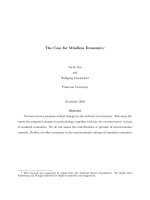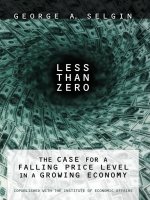Harmonic elliott wave the case for
Bạn đang xem bản rút gọn của tài liệu. Xem và tải ngay bản đầy đủ của tài liệu tại đây (9.88 MB, 212 trang )
Contents
Cover
Title Page
Copyright
Introduction
Chapter 1: R. N. Elliott's Findings: Impulsive
Waves
Ralph Nelson Elliott
The Impulsive Wave Structure
Unbreakable Rules
Elliott's Guidelines
Chapter 2: R. N. Elliott's Findings: Corrective
Waves
Corrective Waves
Chapter 3: Impulsive Wave Modification
Background
Common Wave Characteristics of the Modified
Impulsive Wave
Chapter 4: Projection and Retracement Ratios
Background
Examples of How the Modified Wave Structure
Provides Superior Results
Elliott Structure Relationships versus the Modified
Harmonic Relationships
Other Examples of the Strength and Accuracy of the
Modified Harmonic Structure
Chapter 5: Working with the Modified Wave Structure in
Forecasting
Introduction
Chapter 6: A Case Study in EURUSD
Being Caught with the Wrong Wave Count
Progression Since the Original Analysis
Conclusion
Chapter 7: The Modified Structure in Other Markets
Dow Jones Industrial Average
Gold
French CAC 40 Index
Japanese Nikkei 225 Index
Wheat Futures
Cotton Futures
Index
Copyright © 2011 John Wiley & Sons (Asia) Pte. Ltd.
Published in 2011 by John Wiley & Sons (Asia) Pte. Ltd.
2 Clementi Loop, #02–01, Singapore 129809
All rights reserved.
No part of this publication may be reproduced, stored in a retrieval system, or
transmitted in any form or by any means, electronic, mechanical, photocopying,
recording, scanning, or otherwise, except as expressly permitted by law, without either
the prior written permission of the Publisher, or authorization through payment of the
appropriate photocopy fee to the Copyright Clearance Center. Requests for permission
should be addressed to the Publisher, John Wiley & Sons (Asia) Pte. Ltd., 2 Clementi
Loop, #02–01, Singapore 129809, tel: 65–6463–2400, fax: 65–6463–4605, e-mail:
This publication is designed to provide accurate and authoritative information in
regard to the subject matter covered. It is sold with the understanding that the publisher
is not engaged in rendering professional services. If professional advice or other expert
assistance is required, the services of a competent professional person should be
sought.
Neither the authors nor the publisher are liable for any actions prompted or caused
by the information presented in this book. Any views expressed herein are those of the
authors and do not represent the views of the organizations they work for.
Other Wiley Editorial Offices
John Wiley & Sons, 111 River Street, Hoboken, NJ 07030, USA
John Wiley & Sons, The Atrium, Southern Gate, Chichester, West Sussex, P019
8SQ, United Kingdom
John Wiley & Sons (Canada) Ltd., 5353 Dundas Street West, Suite 400, Toronto,
Ontario, M9B 6HB, Canada
John Wiley & Sons Australia Ltd., 42 McDougall Street, Milton, Queensland 4064,
Australia
Wiley-VCH, Boschstrasse 12, D-69469 Weinheim, Germany
Library of Congress Cataloging-in-Publication Data
ISBN 978–0–470–82870–0 (Hardcover)
ISBN 978–0–470–82872–4 (ePDF)
ISBN 978–0–470–82871–7 (Mobi)
ISBN 978–0–470–82873–1 (ePub)
10 9 8 7 6 5 4 3 2 1
Introduction
It has been 20 years since I began to learn and apply the Elliott Wave Principle to the
markets. I bought two books on the topic, read them thoroughly, and thought I could
begin to predict price movements more effectively. Of course, as anyone will tell you,
it's not as simple as that.
I studiously attempted to apply the principle to daily forex movements, but finding no
success I gave it up . . . several times. What drove me forward was that of all analysts,
it was those who utilized this principle that produced the most accurate forecasts. Other
analysts simply had no clue, and this prompted me to continue the quest to conquer the
challenge.
It took me a full 18 months before I felt that I had mastered the technique to an extent
where I could generally provide more accuracy to my forecasts, but I was not yet at the
stage where there was a high level of consistency. This led me to believe that it was a
technique that demanded a great deal of dedication and practical experience to achieve
success. Strangely enough, even then others still seemed to appreciate my attempts.
Around 16 years ago, I left trading to join the second largest real-time data vendor,
Dow Jones Telerate, to provide specialist analytical support for their clients. I began to
hold seminars for traders in Tokyo, which of course included Elliott Wave. It was a
marvelous experience that deepened my knowledge of technical analysis in general, but
it also took me away from the front line of having to analyze and forecast every day.
It wasn't until around 2004 that I returned to full-time analysis, writing a daily
report which has now developed into The Daily Forecaster, subscribers coming from
retail traders, corporate treasurers handling forex exposures, bank traders, and hedge
funds. Being independent, the need for accuracy was pressing. Subscribers paid up their
bucks and wanted profits. The days of having the backing of a large bank's name,
a good salary, and less risk had passed.
Utilizing R. N. Elliott's wave structure, I became aware that things were not
quite right. The same anomalies in the wave structure repeated themselves over and
over again. The normal Fibonacci projections that are widely quoted didn't work
all that often. Impulsive waves all too often stalled early and missed out a wave. So I
began to adapt the way in which impulsive wave structures develop and to research the
common ratios in projections. After a few months, it was clear that my adaptations
produced far more accurate results in both the projection ratios and the manner in which
impulsive wave structures develop.
It was at this point that the number of subscribers who kindly wrote to compliment the
accuracy of both my forecasts and the daily support and resistance rose considerably.
Another quite common comment was how other market analysts seemed to have no idea
of what will happen next. As one subscriber wrote:
I am also extremely happy that I stuck with you. At the time, you twisted my rubber
arm to continue with the original subscription I had been suffering from a string of
advisors, many of whom were well-intentioned but could not unfortunately, for me,
chew gum and walk straight at the same time—I mean from an analysis point of
view. It was a bit like dining “al fresco” in the middle of a hurricane . . .
By no means am I perfect and I still have varying degrees of success in forecasting,
but the consistency is higher with my approach, and one factor I have noted is that the
“derivatives” of both Fibonacci and harmonic ratios I employ do often provide
powerful reversal signals if my forecasts prove incorrect. The mere fact that support
and resistance levels are more accurate provides more focused points in price action
that identify both trade entry and stop loss/reversal levels that can assist in reducing the
size of losses and thus provide more effective maintenance of capital.
In writing this book to describe my findings I do not wish to imply that R. N. Elliott
failed. In my opinion he was brilliant to make such observations in the first place. I do
not for one moment believe I could have identified and quantified the Wave Principle if
I had no prior foundation on which to work. The ability for me to identify this different
structure of impulsive waves could really only have been managed with the benefit of
modern calculators and charting software. With a few touches of the keyboard I am able
to generate a full range of retracement levels and projections in my spreadsheet. While
Elliott did have access to hourly charts, his ability to scrutinize wave relationships was
limited due to the fact that he would have had to calculate a range of ratios long hand.
Spreadsheets allow these to be available almost instantaneously. All that is needed is to
tap in a few highs and lows. Therefore I prefer to label my findings as a modification
only. R. N. Elliott's work still remains a remarkable feat of observation and
diligence.
Having mentioned to other market professionals that I feel Elliott's structure is
incorrect I have encountered a significant degree of resistance. It's like I have
touched a raw nerve, almost challenging a religious dogma! Therefore, in suggesting this
reappraisal of the impulsive wave structure I realize that I need to offer suitable
substantiated evidence to support my claim, and this I do through the use of wave
relationships. The key to this evidence comes from the fact that the Fibonacci or
harmonic ratios must be present not only within each wave but also within the entire
fractal sequence of waves, so that the waves of lower degrees must generate projection
targets that fit harmoniously into the larger degrees. Each in turn contributes to the next
larger degree.
I have provided a great number of actual examples of analysis and of the different
methods of wave development, and substantiated them all through wave relationships so
there can be no doubt that the modification to the harmonic structure is valid.
Clearly with a new modified harmonic structure some of the rules that have been used
with Elliott's structure have changed and the methodology of recognizing a
correct structure needs a shift in perception and application to forecasting. I have
therefore included a chapter dedicated to providing practical guidance in using the
harmonic structure, how to recognize certain common wave developments, and hints and
tips on how to approach the task of deciphering wave recognition.
I have also included a section on confirming the retracement and projection levels
when reached. While Elliott's observations on alternation and degree are still
mainly valid, very clearly there are multiple potential retracement ratios or projection
targets. Often they can be identified by matching projections from the wave structure of
lower degree, but there can often be situations where two areas can be potential targets,
both garnered from different wave degrees. Use of momentum can clarify these in the
majority of instances.
It is still not the “Holy Grail.” I even doubt that there is such a thing. There are still
enough occasions where it is very difficult to identify the individual waves either due to
exceptionally erratic price development or a rapid move in one direction that makes the
identification of waves nigh on impossible. Extended trending moves are still a big
challenge so there is still more work to do.
In Chapter 5, I have attempted to provide a practical approach to working with
Harmonic Elliott Wave, highlighting some of the problems that arise and how to cope
with or understand methods of recognizing when the analysis is going astray. This is
extended in Chapter 6, which covers what I feel were a sequence of unfortunate calls in
EURUSD. It may sound unusual to point out one's own pitfalls but analysis and
forecasting is not a straightforward or simple matter. During much of the development in
price I held the correct direction, but I made reversal calls at the wrong moments. One
can try to ignore such events, but the manner in which these occurrences are handled is
important in order to quickly get back onto the right track. Chapter 6 is an attempt to
provide some guidelines on how this may be done.
In this book I therefore offer my own observations; others more capable than I can add
to the evidence I will present. I am convinced that changes need to be made and that they
provide a much more reliable structural framework in which to forecast future price
movements. Having worked with this approach for several years and slowly realized
what adjustments need to be made in both price structure and wave relationships, I have
found the changes invaluable in providing forecasts.
One final point I should make is that since I am a foreign exchange analyst, necessarily
the working examples are from the foreign exchange market. However, I have been
asked by subscribers to comment on other markets on occasion. On the first occasion I
was uncertain whether my changes would actually apply in other markets. However, I
have been pleasantly surprised with the results, and have dedicated a chapter to
providing evidence from a range of markets that substantiates my methodology. The first
non—foreign exchange markets to which I applied Harmonic Elliott Wave were the
Dow Jones Industrial Index and gold. The initial wave counts were generated at the
commencement of writing the book. By the time I came to completion these markets had
progressed a long way and followed the anticipated structural progress implied by the
original analysis. I have therefore extended the original analysis to demonstrate the
accuracy of the adaptations made to Elliott's original principle.
Ian Copsey
www.harmonic-ewave.com
Chapter 1
R. N. Elliott's Findings: Impulsive Waves
Ralph Nelson Elliott
Ralph Nelson Elliott was a distinguished businessman, an accountant whose career
began at the age of 25 in 1896. He was a renowned organizer, fastidious in his
approach, and over the following 25 years he rescued a number of distressed companies
and brought them back into profitability. In 1924 he was appointed by the U.S. State
Department as chief accountant for Nicaragua—then under the control of the United
States—to reorganize the finances of the entire country.
However, in 1929 he became seriously ill with pernicious anemia, which kept him
confined to his bed. It was at this time, while recuperating, that he studied stock market
charts, examining price behavior across all time frames. It took over five years for him
to draw his conclusions. In March 1935, as the Dow Jones Average closed almost at its
lows, he published his findings by declaring that the index was making its final bottom.
The accuracy of his findings was impressive, and they were published in his first book
The Wave Principle. He followed up in the early 1940s with an addendum on the
application of the Fibonacci sequence of ratios to his findings on the structure of wave
development.
This became known as the Elliott Wave Principle, and it is applied by what may be
millions of traders around the world in today's markets. Before offering my
modifications to this principle, I will present Elliott's findings and observations,
which still remain the basis of what I consider the most accurate tool in forecasting
markets.
The Wave Principle can be loosely separated into two basic market characteristic
types: trends and consolidation (or correction). Elliott named the trending phase
impulsive while the rest were classed as corrective. I shall reproduce these in full in
order that the original theory is provided, as it still forms the basis of what is a brilliant
example of observation and collation into a methodical tool that can be applied even to
modern markets.
Those readers who are familiar with the principle may wish to move on to Chapter 3.
The Impulsive Wave Structure
Elliott proposed that when price movements demonstrate an underlying trend, they will
always develop in five distinct waves: three in the direction of the trend and two as
corrections to the underlying trend (as shown in Figure 1.1). The three directional
waves are labeled Waves 1, 3, and 5, and the corrective waves as Waves 2 and 4. The
directional waves in a trend are normally referred to as impulsive waves. Once this
five-wave sequence has been completed, a correction will be formed. While a fuller
description of corrective waves will follow, for now I shall simply say that they
develop in three waves and refer to these as Waves A, B, and C.
Figure 1.1 The Simple Wave Structure
Figure 1.2 shows how a five-wave move would appear on a chart, the example being
the hourly EURUSD chart.
Figure 1.2 An Impulsive Wave in EURUSD
Source: FXtrek IntelliChart™ in collaboration with FX-Strategy.com Pro Charts™
Elliott's findings, which were observed over multiple time frames (daily,
weekly, and monthly), were that waves are fractal. This meant that the basis of all
movements, whether in five-minute charts or monthly, are intrinsically related as the
shorter time frames form the building blocks for the larger time frames. This can be
observed in the complex wave structure shown in Figure 1.3.
Figure 1.3 The Complex Wave Structure
Thus, a simple five-wave move at the beginning of a new sequence will form a Wave
(1) and the three-wave correction will then become Wave (2), followed by Wave (3),
Wave (4), and Wave (5). Indeed, this larger five-wave move will form Wave [1] of the
next higher degree, followed by a Wave [2].
Note: In a simple corrective move, Wave A and Wave C will consist of five waves
due to the fact they are counter-trending moves. Wave B will always consist of three
waves, or—as we will find later—a combination of three-wave moves.
Already it becomes apparent that where you see a five-wave directional move—with
the exception of Wave 5—it will always be followed by another five waves.
Figure 1.4 shows how a complex five-wave decline would appear on a chart, the
example being the daily GBPUSD chart.
Figure 1.4 A Complex Impulsive Wave in GBPUSD
Source: FXtrek IntelliChart™ in collaboration with FX-Strategy.com Pro Charts™
Extended Impulsive Waves
Elliott also noted that impulsive waves had an occasional tendency to extend; he
observed that there was more than a single set of impulsive waves in a trend (see Figure
1.5).
Figure 1.5 A Single Extended Impulsive Wave
This is a simple concept, noting that the five waves constructing Wave (3) are made
up of five waves of the same degree. This can perhaps be best described as saying that
if this is a daily chart, then the five waves in Wave (3) are also visible and measurable
in the daily chart rather than, say, the hourly chart. Of course, the impulsive waves 1, 3,
and 5 will be composed of five waves themselves.
In addition to this, Elliott found that there were cases of multiple extensions (as shown
in Figure 1.6).
Figure 1.6 A Double Extended Impulsive Wave
Extended waves may occur in any of the three impulsive waves, but most commonly
in a third-wave position which Elliott observed was generally the wave with the
strongest risk of a powerful trending extension. Considering the often seen reversal
which tends to begin with the market believing that another correction is developing—
thus adding to positions in favor of the prior trend—it makes sense that the third wave is
more often than not the stronger move as it begins with positions being unwound and
fresh positions in the opposite direction being established.
Figure 1.7 displays an extended wave in the Wave (3) position.
Figure 1.7 An Extended Wave in Daily USDCHF
Source: FXtrek IntelliChart™ in collaboration with FX-Strategy.com Pro Charts™
There is always the question of when should we know when an extended wave is
likely to occur. Sometimes it springs upon us quite suddenly and we are left scrambling
to understand what is happening. I have always suggested that if there is any time where
we may anticipate such a move then it must be that perhaps the final stalling area is one
that can be determined from an extension of the prior wave structure. Perhaps we are
looking at a five-wave move in Wave (C), and this has projections in a wave equality
move around the end of Wave (5).
Later on I shall highlight why I now feel this is unlikely.
Wave 5 Position
Elliott noted a variety of ways a Wave 5 could develop. This of course included an
extended Wave 5 that would look similar to Figure 1.8.
Figure 1.8 Extended Wave 5
Again, the argument tends to be that our target is much higher, and since the normal
extension ratios would not reach that target, we should be aware of the potential for an
extended Wave (5).
Figure 1.9 displays a long rally in the weekly AUDJPY chart. Note that in this original
Elliott method of counting, Wave (3) was extended and was followed by an extended
Wave [5] of Wave (5). Clearly I disagree with this counting method, and will highlight
this in Chapters 3 and 4.
Figure 1.9 An Extended Wave in Weekly AUDJPY
Source: FXtrek IntelliChart™ in collaboration with FX-Strategy.com Pro Charts™
Another potential Wave 5 is a Diagonal Triangle. Elliott noted that this has a different
structure from a normal impulsive move, being constructed of five waves of three and
commonly holding within a channel or within converging lines (as shown in Figure
1.10).
Figure 1.10 Diagonal Triangle Wave (5)
In traditional pattern analysis this is obviously nothing more than a wedge, but Elliott
refined the expectations by detailing that there needs to be five waves, three in the
direction of the underlying trend with two intervening corrective waves. In general,
those that practice Elliott Wave tend to change the labeling to (i), (ii), (iii), and so on, to
differentiate impulsive waves 1, 3, and 5 constructed of five waves with those
constructed of three waves.
Figure 1.11 shows how a Diagonal Triangle Wave 5 wave rally would appear on a
chart, the example being the five-minute EURUSD chart.
Figure 1.11 A Diagonal Wave (5) in the Five-Minute EURUSD Chart
Source: FXtrek IntelliChart™ in collaboration with FX-Strategy.com Pro Charts™
Elliott proposed that extended waves could appear in any of the three impulsive
waves—that is, Waves 1, 3, or 5—but only one impulsive wave could be extended in
any one sequence of five waves.
In my own findings I feel this is really a reflection of an alternative structure and was
misunderstood. Later, through the use of detailed measurements of waves, I shall
describe why I have come to this conclusion.
Failed Fifth Waves
Elliott noticed that on occasion Wave 5 fails to extend beyond the extreme of Wave 3
and generates a reversal directly (as shown in Figure 1.12).
Figure 1.12 A Failed Fifth Wave
This has been in mainstream Elliott Wave counting, but from my own perception it is a
convenient way to account for the loss of an extra anticipated move higher. I feel this
actually indicates that the structure is incorrect. However, I shall discuss this later when
explaining my findings.
Figure 1.13 displays two five-wave rallies, the first in Wave (A) with a distinct
extended wave in Wave (3), while the second in Wave (C) has an extended Wave 5 of
Wave (5). In Wave (5) the final Wave v of 5 appears to have developed as a failed fifth
wave.
Figure 1.13 Two Sets of Five-Wave Rallies in AUDUSD
Source: FXtrek IntelliChart™ in collaboration with FX-Strategy.com Pro Charts™
Again, I shall describe later in Chapter 4 why I feel this count is incorrect.
Unbreakable Rules
Elliott detailed only three rules in the entirety of his findings, and all were confined to
the actions of impulsive waves.
Rule 1: Wave 2 can never retrace more than 100% of Wave 1.
This is quite logical. If we are talking about an impulsive wave representing the
underlying trend, it would be illogical to have a retracement that breaks the basic
definition of a trend as defined by classical technical analysis.
An uptrend is a sequence of higher highs and higher lows. Once that sequence is
broken, the uptrend can be assumed to have ended. A downtrend is a sequence of lower
lows and lower highs. Once that sequence is broken, the downtrend can be assumed to
have ended.
Rule 2: Wave 3 is never the shortest of the three impulsive waves.
Elliott also noted that statistically Wave 3 is generally the longest, and of all extended
waves it is Wave 3 that most commonly extends as this is where the market has realized
that it has the wrong position, and exits from its prior trending position to enter into the
anticipated new trend direction.
Rule 3: Wave 4 in an impulsive wave never retraces to a level below the peak of
Wave 1 in an uptrend or above the trough of Wave 1 in a downtrend.
This rule basically highlights that during a trend that indicates a sustained movement
in one direction, the extreme of Wave 4 would not be expected to retrace so deep as to
overlap with the extreme of Wave 1.
Elliott's Guidelines
Elliott also noted some guidelines that he would not count as rules but noticed a high
ratio of instances where these factors occurred. They are helpful hints in outlining highprobability outcomes in certain circumstances, ones I have found exceptionally useful in
my own analysis and which indeed blend in well with my own views on price structure.
Alternation
Elliott noticed a strong tendency for corrective waves within an impulsive structure to
alternate in terms of depth and complexity. I shall cover corrective waves briefly at this
point.
If Wave 2 develops in a simple manner (an ABC Zigzag move) then Wave 4 will tend
to be complex (Triangle, Flat, Expanded Flat, or Triple Three). If Wave 2 develops in a
complex manner then Wave 4 tends to be a simple ABC move.
In addition, alternation covers the depth of the retracements in Waves 2 and 4. If Wave
2 was shallow then Wave 4 will be deep, and vice versa (as shown in Figure 1.14).
Figure 1.14 Deep Wave (2) and Shallow Wave (4) Demonstrating Alternation in FiveMinute GBPUSD
Source: FXtrek IntelliChart™ in collaboration with FX-Strategy.com Pro Charts™
In this example of a five-wave decline in the five-minute GBPUSD chart, Wave (2)
retraced Wave (1) by 74.8%. Conversely, Wave (4) retraced only 18.4% before seeing
a Diagonal Triangle decline in Wave (5).
B Waves
The second guideline Elliott noticed was that after the completion of a three-wave move
there is a tendency for price to reverse to the area of the preceding Wave B (as shown in
Figure 1.15). This may prove temporary or a long period depending on which part of the
wave structure it occurred in.
Figure 1.15 Following the Completion of an ABC Move Lower Price Retraces to the
Prior Wave (B)
Source: FXtrek IntelliChart™ in collaboration with FX-Strategy.com Pro Charts™
This chart is one such example of an event that occurs so frequently that it provides an
excellent first target in a retracement.









